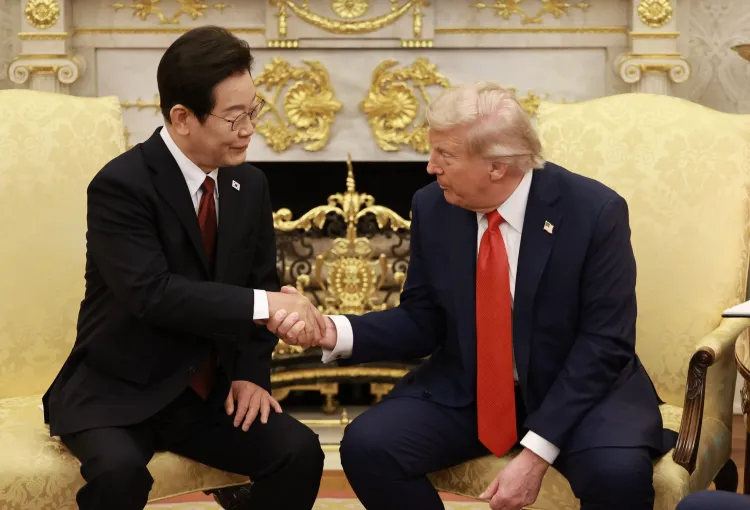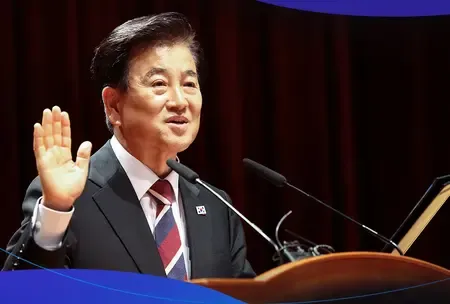Did Trump Successfully Land in South Korea for High-Stakes Summits with Lee and Xi?

Synopsis
Key Takeaways
- Trump's visit to South Korea is focused on trade agreements and investment discussions.
- A trade framework deal of US$350 billion investment is on the table.
- Upcoming meetings with Xi Jinping could reshape US-China relations.
- Speculation about a meeting with Kim Jong-un adds another dimension to the visit.
- Global market responses may depend on the outcomes of these high-stakes summits.
Seoul, Oct 29 (NationPress) US President Donald Trump has landed in South Korea on Wednesday, gearing up for crucial summits with President Lee Jae Myung and Chinese President Xi Jinping during the Asia-Pacific Economic Cooperation (APEC) meeting taking place in the southeastern city of Gyeongju.
This marks Trump's inaugural Asia trip in his second term, as he aims to secure vital trade and investment agreements following recent market fluctuations and rising tensions over his proposed steep tariffs on imports.
After departing from Tokyo aboard Air Force One earlier that day, Trump arrived at Gimhae International Airport in the southeastern city of Busan.
A meeting with Lee in Gyeongju is scheduled later on Wednesday, marking their second summit in roughly two months. A significant point of interest is whether the two nations can finalize a trade framework deal established in July, as differing evaluations of their negotiations have emerged from both Seoul and Washington.
The framework deal proposes that South Korea invests US$350 billion in the United States in return for a reduction in reciprocal tariffs from 25 percent to 15 percent, yet the agreement remains unimplemented due to unresolved details concerning the investment package.
Trump noted on Friday that a trade agreement with South Korea is “pretty close to being finalized.”
Conversely, in a Bloomberg interview on the same day, Lee presented a contrasting view, as reported by Yonhap news agency.
“The method of investment, the amount of investment, the timeline and how we will share the losses and divide the dividends – all of these remain sticking points,” he stated.
Trump's two-day state visit to South Korea is garnering significant interest due to factors beyond just Seoul and Washington.
His much-anticipated meeting with Xi on Thursday – their first discussion since 2019 – will be closely monitored for any potential resolutions regarding the escalating US-China trade tensions.
Recently, China has tightened its export controls on rare earth materials, which are essential for producing advanced military and commercial goods, including fighter jets and robots. In response, Trump has threatened to impose an additional 100 percent tariff on Chinese products starting November 1.
The trade disputes between the two largest economies encompass additional issues as well. China halted its purchases of soybeans from the US this year, likely affecting American farmers, a crucial support base for Trump. Simultaneously, the US has utilized tariffs to compel China to curb its fentanyl trafficking.
Trump has expressed optimism regarding his forthcoming discussion with Xi.
“When we leave South Korea, it could be wrong, but I believe we’ll conclude with a robust trade agreement,” he remarked last week. “Both of us will be satisfied.”
Apart from the summits, Trump's visit has also sparked speculation about a possible meeting with North Korean leader Kim Jong-un.
The two leaders previously convened three times during Trump's first term – in Singapore in June 2018, in Vietnam in February 2019, and at the inter-Korean truce village of Panmunjom in June of that year.
These meetings were aimed at achieving an agreement on dismantling North Korea’s nuclear weapons program in exchange for US concessions, including sanctions relief, but negotiations deteriorated due to disagreements on the sequence of actions.
Trump has consistently expressed his willingness to engage with Kim again, even if it requires extending his stay in South Korea.
The North has yet to react to these overtures.










